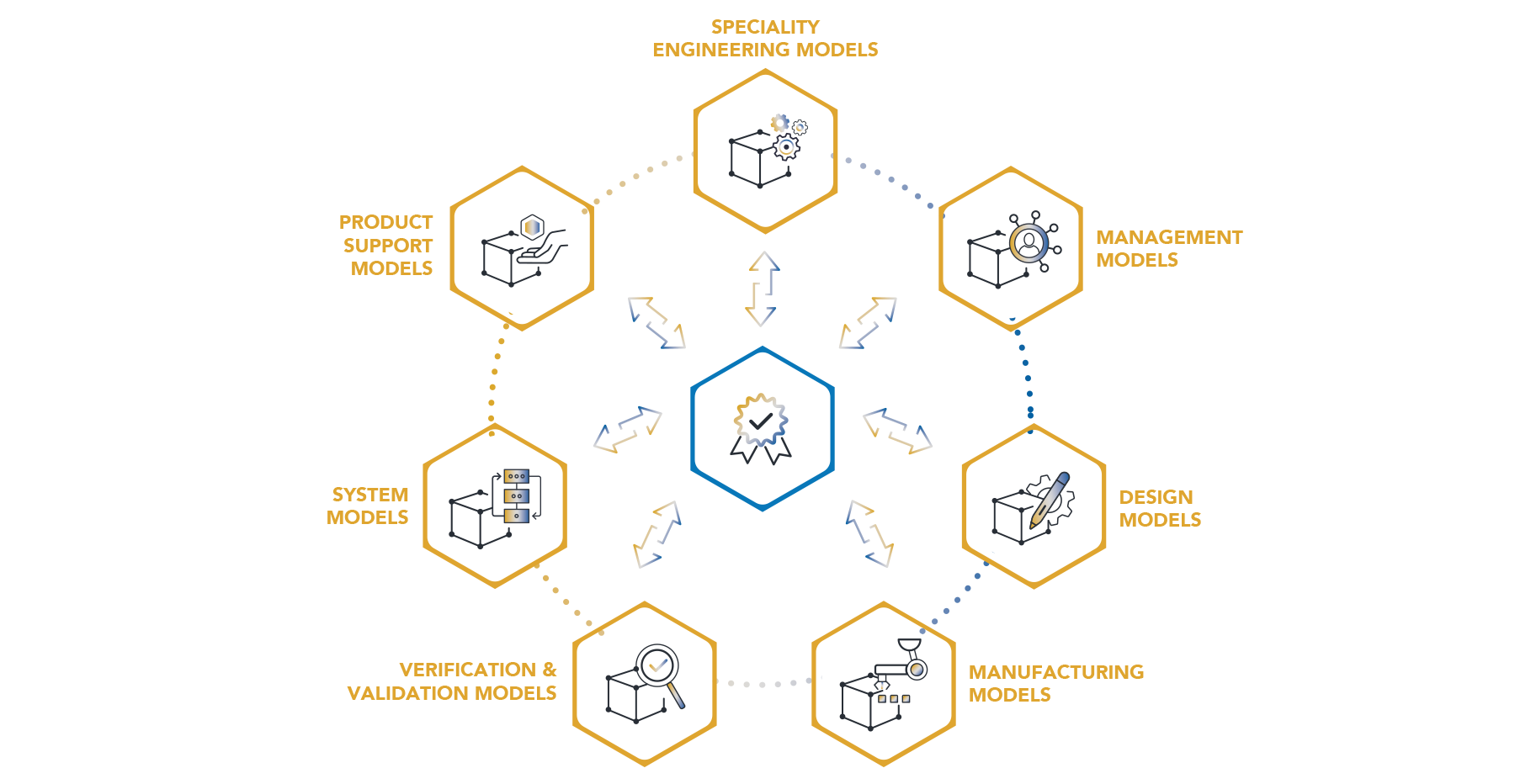
What is Model-Based Systems Engineering (MBSE)?
An Introduction and Beginner’s Guide to Model-Based Systems Engineering
Blog Article | December 20, 2023
Increasing product complexity, more regulations, more competition, reduced time to market, fewer resources means that every company doing product development has to maximize the value of its product development process. Model-based systems engineering (MBSE) has emerged as the right methodology for this need. However, to get the most out of deploying MBSE, it’s important to understand what it is, what the benefits of using it are, how to prepare to introduce it, and quick ways to start deployment. This guide will help you to reach that understanding.
What is Model-Based Systems Engineering (MBSE)?
Model-based systems engineering (MBSE) is defined by the International Council on Systems Engineering (INCOSE) as follows.
“An approach to engineering that uses models as an integral part of the technical baseline that includes the requirements, analysis, design, implementation, and verification of a capability, system, and/or product throughout the acquisition life cycle.”

MBSE is built around a set of system representations that are captured in a shared data model. The shared data model ensures consistency between representations and enables automation to support analyses, change management, and report generation. The model-based approach contrasts with the traditional document-based approach to systems engineering. The document-based approach requires significant manual intervention and alignment meetings to achieve the same level of consistency and process support.
MBSE enables teams and team members to manage a product development lifecycle more efficiently and effectively. Defects such as missed requirements, conflicting requirements, and unfulfilled requirements are identified faster and earlier in the design process, reducing costs and speeding time to market. The complexity of today’s products and decreasing concept-to-market time demands have created the need for the MBSE approach to product development.

Who Uses Model-Based Systems Engineering (MBSE)?
Leading Fortune 100 companies like Apple, Lockheed Martin, Caterpillar, and General Electric use MBSE. Government agencies use it as well, including the National Aeronautics and Space Administration (NASA), and the United States (U.S.) Department of Energy (DOE), and the U.S. Department of Defense (DOD). In fact, the DOD requires every contractor to use MBSE on every project. All have recognized that MBSE fosters innovation and facilitates continuous improvement while reducing time and costs.
One industry example is aerospace and defense, where innovation rules. Companies are using MBSE for developing highly complex systems for propulsion, supersonic and hypersonic flight, and urban air mobility (UAM). Models and simulations are used for the development of electric vertical takeoff and landing (eVTOL) aircraft. The engineers are designing overall systems that are connected to multiple systems and subsystems. All are integrated and operate in unison.
Discover the MBSE Revolution in Systems Engineering
Watch our Customer Enablement Series (CES): Top 5 Ways to Get Started With MBSE!
MBSE vs. Document-Based Systems Engineering (DBSE)
MBSE fosters open lines of communication between engineers and stakeholders. In comparison, DBSE often creates separate silos of communication that block information sharing. Plus, DBSE has multiple authors developing and updating countless documents to portray the system design. The table below highlights some of the clear differences between MBSE and DBSE.
MBSE |
DBSE |
|---|---|
| Model-based, integrated, and automated approach | Document-based, separated, and manual approach |
| Models and illustrations are used to share information | Text documents are used to share information which can cause design confusion and misunderstandings |
| Design version updated automatically in real time, so all team members have the current version | Design version updated manually which is dependent on updates by multiple authors which can result in team members having different versions |
| Models are the primary means of communication between team members and stakeholders that are automatically updated in real time | Multiple documents are the means of communication between team members and stakeholders that are manually updated |
| Virtual models and simulations are used for development | Prototypes and text documents are used for development |
| Language used is SysML and tightly controlled | Text is the written language like English with only simplistic rules for the structure of a formal description |
| Fixed quality standards that are tracked | Quality standards are not set and vary |
| Engineering data of each development stage are stored in a model located in one place | Engineering data of each development stage are stored in documents located in multiple places and are managed by several authors responsible for manual updating |
The Benefits of Model-Based Systems Engineering (MBSE)
MBSE offers a range of benefits over traditional document-based systems engineering. Some of them are highlighted below.
Higher Performing Designs & Quality
MBSE looks at the big picture including a potential new system, its subsystems, technology, etc. It explores how they are interrelated, behave, and perform. Using simulation data, all are integrated and configured to work in harmony which brings higher performance and quality.
Lower Development Costs
Designs are developed with virtual models and tested with simulations whereby saving the cost of building and testing several prototypes.
Higher Efficiency
By automating specific tasks and providing a common representation for the system, MBSE can help to streamline the design process. This can reduce the time and effort needed to complete the design.
Faster Development Process & Time to Market
MBSE virtual models and simulation data are stored in a single place that is easy for all team members and stakeholders to access. Making changes is easy, and updates are done automatically. All these factors remove barriers that can slow down progress Instead, MBSE streamlines development so the product is ready to go to market in less time.
Highly Collaborative & Productive Environment
MBSE eliminates silos and creates an open channel of communication conducive to collaboration. Engineers and stakeholders can easily share the most current model, simulation data, considerations, recommendations, changes, etc. It creates an open environment where more people participate and contribute, which raises productivity. Plus, it creates a place where employees learn from each other.
Lower Risk
Risk levels are lowered for products in development by identifying issues earlier in the process before they evolve into problems.
Fewer Errors
Using computer-based tools and techniques in MBSE can help reduce the risk of errors during the design process through increased traceability.
Higher Clarity & Understanding
MBSE helps team members and stakeholders clearly understand what is being developed from the use of illustrations and puts everyone on the same page.
Higher Participation & Collaboration
The vertical hierarchy model has been eliminated and replaced with a top-down approach, which is more conducive to participation and collaboration.
Higher Profits
A model-based approach with virtual modeling, system integration, automation, collaboration, and clear communication brings higher effectiveness and efficiency that leads to higher profits.
Increased Customer Satisfaction
MBSE may increase customer satisfaction by producing higher-quality designs delivered more efficiently.
Requirements for Adoption of Model-Based Systems Engineering (MBSE)
MBSE can enable your company to develop better products faster. Achieving it requires preparation before adoption. Key requirements include the following.
Pick & Prepare Experts
You will want to have at least a few on-site experts of MBSE. They will be the “go-to” person for questions. Select from employees your MBSE Subject Matter Experts (SME) and project leaders. Provide them with training and coaching so they are ready for upcoming MBSE decisions. Plus, do some benchmarking to create a baseline for gauging how you are progressing.
Preplan Change
Moving to MBSE is a challenging change for any company. Those that are successful create and execute a change management plan. It should include why the change to MBSE is being made, the urgency, and how an employee should demonstrate being onboard. A MBSE deployment roadmap is also a good idea to organize efforts contributing to the MBSE vision.
Recruit Change Ambassadors
Recruiting some ambassadors to promote MBSE and changing to it is a good idea. be the role model. Have the ambassadors use MBSE language to indicate the change is starting.
Change Culture & Gain Commitment
Start changing the company culture by having the SMEs and Ambassadors share with employees your MBSE vision, goals, objectives, roadmap, and resources. Start persuading stakeholders to make a commitment and get it done.
Provide Essential Capabilities
Align needed capabilities to the organization’s transformation objectives and create a unique resultant plan.
Scale Accordingly
Start with a pilot project like a research project. Then, as you expand the scale accordingly.
Top 5 Ways To Get Started With MBSE
The best way to get started with modeling is to start modeling. By using models, extensions, and tools, you will gain a clearer understanding of your organization's requirements for methodology and processes. Start by focusing on the MBSE approach rather than getting bogged down in details like which diagram to use with perfect syntax. It’s more important you first learn how systems engineering models and modeling will add value to your organization.
The top five ways to get started with MBSE are by (1) tackling the challenges of creating a system architecture document, (2) creating Interface Control Models, (3) capturing operational scenarios as validation tests, (4) linking test plans to system structure, and (5) showing the allocation of parameters in a structure model. Let's explore each of these challenges individually.
1
Tackling the Challenges of Creating a System Architecture Document
2
Creating Interface Control Models
3
Capturing Operational Scenarios as Validation Tests
4
Linking Test Plans to System Structure
5
Showing the Allocation of Parameters in a Structure Model
Let’s Explore Each of These Challenges Individually
1. Create a System Architecture Document
All system engineering requires some documentation. For MBSE, the most important is a System Architecture Document (SAD). Creating a SAD is critical because it formally documents overviews of the system, its architecture, drivers, related views of the architecture, and ancillary information. It is the beginning point for engagement with stakeholders.
A SAD includes the following:
- Introduction (purpose & history)
- General Overview (assumptions & constraints)
- Design Considerations
- Mission Profiles (scenarios)
- Interfaces (context model)
- System Architecture (internal block diagram)
- Key Attributes
SADs improve stakeholder understanding of critical decisions. The document accomplished it by providing an overall system structure regarding its major component elements and their relationships. It also shows how components fulfill architecturally significant requirements and constraints. Plus, it has the foundation on which the system is based, including design, implementation, integration testing, deployment, and maintenance.
The information in a SAD provides your starting point for estimating system development complexity, cost, and schedule. Plus, it gives what you need to develop work assignments and subcontracts during the acquisition and development of the system. The SAD supports the analysis and verification of system architecture, which reduces the risk of less than best decisions. The document also ensures rationales (e.g., engineering tradeoffs) and preservation of architectural choices.
2. Create Interface Control Models
With MBSE, you create Interface Control Models (ICMs) looking beyond the overall system. ICMs show subsystems (i.e., Guidance, Navigation & Control) and components (i.e., propulsion, payload, and Avionics with Command & Data Handling). The models also have exploratory text incorporated into existing interface control documentation that provides further details.
ICMs also capture interfaces within a system, such as command and telemetry (cmd & tlm), fuel lines, and GN&C sensor links). Data exchanges are identified as well, like sensor control, commands, and telemetry. All this combined gives you the capability of verifying completeness and consistency via a visual check.
3. Capture Operational Scenarios as Validation Tests
Before system development can even begin, you need to identify the user's needs. MBSE uses the best way of capturing needs with operational scenarios as validation tests. The approach provides more detailed versions of the mission profiles. Validation tests address the operational scenarios and provide validation.
4. Link Test Plans to System Structure
It is standard practice to connect test plans to requirements for determining which needs are and are not met during validation and verification. But MBSE provides a better way of looking at the status. Instead, MBSE links the test cases to the system structure, which adds the following capabilities.
- Identification of problematic subsystems
- Detection of missing verification tests
- From a system readiness mindset, assess project status.
The new capabilities enable you to view the system status based on verification and validation testing.
5. Show Allocation of Key Parameters in a Structure Model
The process of allocating parameters to subsystems and components generates valuable insights for the analysis and synthesis of the system architecture. It is often done by looking at critical system attributes, also called design parameters, presented in tables and analysis models.
The approach fails to indicate how to make potential trade-offs between subsystems and components to achieve the required results. Instead, MBSE captures equations relating to parameters and the latest allocations. As a result, systems engineers identify constraints and receive guidance that improve designs and gain better results.
The Best Choice for a Successful Future
Congratulations, you’ve finished this guide! You’re off to a good start on using MBSE to enhance your product development efforts. See the other sources and further reading below to continue your journey. Lastly, if you want to reach out to Saratech for more information and/or assistance, contact us.

Sources
1. Siemens Special Edition, MBSE for Dummies, Steve Kaelble
https://resources.sw.siemens.com/en-US/e-book-mbse-for-dummies
2. Introduction to Model-Based Engineering, Dr. Bruce Powel Douglass, Ph. D.
3. Systems Engineering & MBSE Tool Market Size, Trends and Forecast to 2030, LinkedIn
https://www.linkedin.com/pulse/systems-engineering-mbse-tool-market-size-trends
4. Systems Engineering & MBSE Tool Market Outlook by 2030 with Demand, LinkedIn
https://www.linkedin.com/pulse/systems-engineering-mbse-tool-market-outlook-2030
5. Systems Engineering & MBSE Tool Market to Experience Strong Growth During The Forecast Period 2023-2030, Small Business World Magazine
Further Viewing
Model-Based Systems Engineering (MBSE)
https://www.youtube.com/watch?v=qphhWuh_LrA
Model-Based System Engineering in Agile Development
https://www.youtube.com/watch?v=QIwo-jyP-UA
Getting Started with MBSE Webinar
https://saratech.com/event/top-5-ways-to-get-started-with-mbse/

